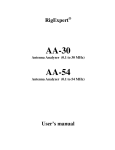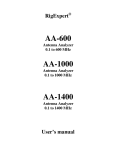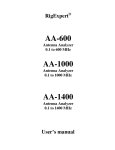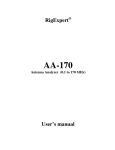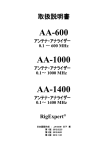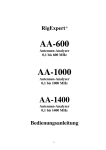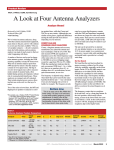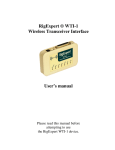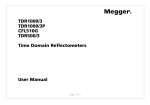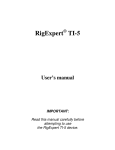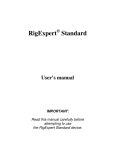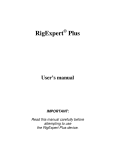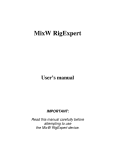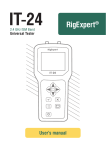Download Manual pdf
Transcript
RigExpert® AA-230 Antenna Analyzer (0.3 to 230 MHz) AA-230PRO Antenna Analyzer (0.3 to 230 MHz) + Time Domain Reflectometer AA-520 Antenna Analyzer (1 to 520 MHz) User’s manual Table of contents 1. Description.............................................................................. 3 2. Specifications.......................................................................... 4 3. Precautions.............................................................................. 5 4. Operation ................................................................................ 6 4.1. Main menu........................................................................ 6 4.2. Single- and multi-point measurement modes .................... 6 4.2.1. SWR mode.................................................................. 6 4.2.2. SWR2Air mode .......................................................... 7 4.2.3. MultiSWR mode......................................................... 7 4.2.4. “Show all” mode......................................................... 8 4.3. Graph modes..................................................................... 9 4.3.1. SWR graph ................................................................. 9 4.3.2. R,X graph ................................................................... 9 4.3.3. Memory operation..................................................... 10 4.4. Settings menu.................................................................. 10 4.5. Computer connection ...................................................... 10 4.6. Charging the battery........................................................ 11 4.7. Meter test mode .............................................................. 11 5. Applications.......................................................................... 12 5.1. Antennas ......................................................................... 12 5.1.1. Checking the antenna................................................ 12 5.1.2. Adjusting the antenna ............................................... 12 5.2. Coaxial lines ................................................................... 13 5.2.1. Open- and short-circuited cables............................... 13 5.2.2. Cable length measurement ........................................ 13 5.2.3. Velocity factor measurement .................................... 15 5.2.4. Cable fault location ................................................... 15 5.2.5. Making 1/4-λ, 1/2-λ and other coaxial stubs ............. 16 5.2.6. Measuring the characteristic impedance.................... 17 5.3. Measurement of other elements ...................................... 18 5.3.1. Capacitors and inductors........................................... 18 5.3.2. Transformers............................................................. 19 5.4. RF signal generator ......................................................... 19 6. TDR (Time Domain Reflectometer) mode............................ 20 6.1. Theory ............................................................................ 20 6.2. Practice ........................................................................... 23 2 1. Description RigExpert AA-230, AA-230PRO and AA520 are powerful antenna analyzers designed for testing, checking, tuning or repairing antennas and antenna feedlines. Graphical SWR (Standing Wave Ratio) and impedance display are key features of these analyzers which significantly reduce the time required to adjust an antenna. Easy-to use measurement modes, as well as additional features such as memory storage and connection to a personal computer, make RigExpert analyzers attractive for professionals and hobbyists. The new MultiSWR™ and SWR2Air™ (AA-230 and AA-230PRO only) modes are unique for these antenna analyzers. The built-in TDR (Time Domain Reflectometer) mode which is available in RigExpert AA-230PRO is ideal for locating cable faults. The following tasks are easily accomplished by using these analyzers: • Rapid check-out of an antenna • Tuning an antenna to resonance • Comparing characteristics of an antenna before and after specific event (rain, hurricane, etc.) • Making coaxial stubs or measuring their parameters • Cable fault location • Measuring capacitance or inductance of reactive loads 3 Antenna connector LCD (Liquid Crystal Display) Keypad Charger connector (9-14V, 500 mA DC) 5. Power button 6. USB connector 1. 2. 3. 4. 2. Specifications Frequency range: AA-230, AA-230PRO: 0.3…230 MHz; AA-520: 1…520 MHz Display modes: - SWR at single or multiple frequencies - SWR, R, X, Z, L, C at single frequency - SWR graph - R, X graph - AA-230PRO: Impulse response and step response graphs [RigExpert AA-520 displays absolute value of the reactance] Single- and multi-frequency measurement: - Frequency resolution: 1 kHz - SWR-only mode: easily-readable bar - SWR range: 1…10 - SWR display for: AA-230, AA-230PRO: 25, 50, 75 and 100 Ohm systems; AA-520: 50 Ohm systems - R, X range: AA-230, AA-230PRO: 0…1000, -1000…1000 Ohm; AA-520: 0…250, 0…250 Ohm SWR and R, X graphs: - 100 points plot - Sweep width: AA-230, AA-230PRO: 0.01…230 MHz; AA-520: 0.1…520 MHz - Frequency resolution: 1 kHz - SWR range: 1…10 - SWR display for: AA-230, AA-230PRO: 25, 50, 75 and 100 Ohm systems; AA-520: 50 Ohm systems - R, X range: AA-230, AA-230PRO: 0…200, -200…200 Ohm; AA-520: 0…200, 0…200 Ohm - Memories: AA-230, AA-520: 100 memories to store and recall graphs; AA-230PRO: 90 memories to store and recall graphs - Presets for radio amateur bands Time domain reflectometer mode (AA-230PRO only): - 100 points plot - Measurement for 25, 50, 75 and 100 Ohm systems - Resolution: about 20 cm (8”) - Max. distance: about 300 m (1000 ft) - Cable velocity factor: 0.5 to 1 - 10 memories to store and recall graphs RF output: - Connector type: AA-230, AA-230PRO: UHF (PL); AA-520: N - Output power: AA-230, AA-230PRO: typ. +10 dBm; AA-520: typ. +5 dBm Power: - 4.8V, 1800 mA·h, Ni-MH battery - Max. 3 hours of continuous measurement - Max. 2 days in stand-by mode - External 9…14V, 500 mA charger - Full charge time: 10…12 hours Interface: - 128x64 graphical LCD with backlit - 6x3 keys on the water-proof keypad - Multilingual menus and help screens - USB connection to the personal computer Dimensions: 23·10·5.5 cm (9·4·2”); Operating temperature: 0…40 °C (32…104 °F) Weight: 650g (23 Oz) 4 3. Precautions Never connect the analyzer to your antenna in thunderstorms. Lightning strikes as well as static discharge may kill the operator. Never leave the analyzer connected to your antenna after you finished operating it. Occasional lightning strikes or nearby transmitters may permanently damage it. Never inject RF signal into the analyzer. Do not connect it to your antenna if you have active transmitters nearby. Avoid static discharge while connecting a cable to the analyzer. It is recommended to ground the cable before connecting it. Do not leave the analyzer in active measurement mode when you are not actually using it. This may cause interference to nearby receivers. If using a personal computer, first connect the cable to the antenna connector of the analyzer. Then plug the analyzer to the computer USB port. This will protect the analyzer from static discharges. 5 4. Operation 4.1. Main menu The on-screen menu system of RigExpert antenna analyzers provides a simple but effective way to control the entire device. Once the analyzer is turned on, the Main menu appears on the LCD: The Main menu contains a brief list of available commands. By pressing keys on the keypad, you may enter corresponding measurement modes, set up additional parameters, etc. Press the F key to see other menu items. There are two icons displayed in the top-right corner of the Main menu screen: • The USB icon is displayed when the analyzer is plugged to a personal computer; • The charging indicator shows battery charging level. RigExpert antenna analyzers are self-documenting: pressing the 1 key will bring a help screen with a list of available keys for the current mode. 4.2. Single- and multi-point measurement modes In single-point measurement modes, various parameters of antenna or other load are measured at a given frequency. In multi-point modes, several different frequencies are used. 4.2.1. SWR mode The SWR mode (press the 7 key in the Main menu) displays the SWR bar as well as the numerical value of this parameter: 6 Set the desired frequency (the 2 key) or change it with left or right arrow keys. Press the ok key to start or stop measurement. The flashing antenna icon in the topright corner indicates when the measurement is started. You may activate or deactivate audio indication of SWR by pressing the 0 key. In this mode, beeps of different length correspond to different values of the measured SWR. Pressing the 1 key will show a list of other commands. 4.2.2. SWR2Air mode RigExpert AA-230 and AA-230PRO present a new SWR2Air mode which is designed to help in adjusting antennas connected via long cables. This task usually involves two persons; one adjusting the antenna and the other shouting out the SWR value as it changes at the far end of the feedline. There is an easier way to do the same job by using the SWR2Air mode. The result of SWR measurement is transmitted on a user specified frequency where it can be heard with a portable HF or VHF FM radio. The length of audio signal coming from the loudspeaker of the portable radio depends on the value of measured SWR. The SWR2Air mode is activated by pressing the F + OK combination in the SWR measurement screen. F + 2 allows setting the frequency to tune the receiver to. 4.2.3. MultiSWR mode RigExpert antenna analyzers have a unique ability to display SWR for up to five different frequencies at a time. 7 You may use this feature to tune multi-band antennas. Use up and down cursor keys to select a frequency to be set or changed. Press the 0 key to switch between SWR bars and numerical representation of these parameters. 4.2.4. “Show all” mode The Show all mode (the 8 key) will show various parameters of a load on a single screen. Particularly, SWR, |Z| (magnitude of impedance) as well as its active (R) and reactive (X) components are shown. Additionally, corresponding values of inductance (L) or capacitance (C) are displayed: [Please notice that RigExpert AA-520 displays absolute value of the reactance, |X|.] For this this mode, you may choose either series or parallel model of impedance of a load through the Settings menu: • In the series model, impedance is expressed as resistance and reactance connected in series: • In the parallel model, impedance is expressed as resistance and reactance connected in parallel: 8 4.3. Graph modes A key feature of RigExpert antenna analyzers is ability to display various parameters of a load graphically. Graphs are especially useful to view the behavior of these parameters over the specified frequency band. 4.3.1. SWR graph In the SWR graph mode (press the 4 key in the Main menu), values of the Standing Wave Ratio are plotted over the specified frequency range: You may set the center frequency (the 2 key) or scanning range (the 3 key). By using arrow keys, these parameters may be increased or decreased. Press the ok key to refresh the graph. The 0 key opens a list of radio amateur bands to set the required center frequency and scanning range quickly. Also, you may use this function to see the whole frequency range supported by the analyzer. Press the 1 key to access the list of additional commands for this mode. 4.3.2. R,X graph In the R,X graph mode (press the 5 key in the Main menu), values or R (active part of the impedance) and X (reactive part) are plotted as solid and dotted lines, respectively. 9 R,X graph – series model R||,X|| graph – parallel model In these graphs, positive values of reactance (X) correspond to inductive load, while negative values correspond to capacitive load. Please notice the difference in the plots when the series or parallel model of impedance is selected through the Settings menu. [Please notice that RigExpert AA-520 displays absolute value of the reactance, |X|.] 4.3.3. Memory operation In the SWR graph and R,X graph modes, you may choose to scan to memory (the 6 key). Later, you may recall ( 9 ) the plots from the specified memory. Additionally, the F + 9 combination opens the editor of memory slot names. 4.4. Settings menu The Settings menu (press the 0 key in the Main menu) contains various settings for the analyzer. Press 0 once again to access additional settings. The Frequency correction sub-menu allows correcting the internal VFO frequency (ppm [parts per million] units are used). The Anti-RF feature [AA-520 only] may be used to increase RF immunity (for instance, in case of active transmitters located nearby). 4.5. Computer connection RigExpert antenna analyzers may be connected to a personal computer for displaying measurement results on its screen, taking screen shots of the LCD, as well as for updating the firmware. A conventional USB cable may be used for this purpose. The supporting software is located on the supplied CD. After installing from the CD, please see the Software Manual for details. 10 4.6. Charging the battery Use the supplied DC adapter or any other 9…14V DC source as an external charger for the built-in Ni-MH battery. A car lighter cable may be used for this purpose. You may have the charger connected while operating the analyzer. If the analyzer is being used for the first time, it is recommended to perform a full 10 to 12-hour charging cycle. When the battery is fully charged, it starts heating (instead of absorbing electric energy). It is a good idea to stop charging if the battery becomes warm. While it is safe to leave the charging mode for a long period of time, it is recommended to do this no more than 10 to 12 hours for longer battery life. 4.7. Meter test mode This mode is designed to check the RF output as well as two RF detectors of the analyzer. Enter the Meter test mode by pressing 3 in the second screen of the Settings menu. With no load at the antenna connector, the display should look like shown on the picture: For the 50-Ohm load, the filled bars should stand at corresponding positions (notice the “no load” and “50 Ω” marks): If the bars are not filled at all, the RF output stage or/and detectors are not working properly in the analyzer. 11 5. Applications 5.1. Antennas 5.1.1. Checking the antenna It is a good idea to check an antenna before connecting it to the receiving or transmitting equipment. The SWR graph mode is good for this purpose: The above picture shows SWR graph of a vertical VHF antenna connected via the 40 m (131 ft) cable. The operating frequency is 146.2 MHz. The SWR at this frequency is about 1.1, which is acceptable. The next screen shot shows SWR graph of a simple dipole antenna with a desired operating frequency of 14.1 MHz: The actual resonant frequency is about 13.4 MHz, which is too far from the desired one. The SWR at 14.1 MHz is about 2.5, which is not acceptable in most cases. 5.1.2. Adjusting the antenna When the measurement diagnoses that the antenna is off the desired frequency, the analyzer can help in adjusting it. 12 Physical dimensions of a simple antenna (such as a dipole) can be adjusted knowing the actual resonant frequency and the desired one. Other types of antennas may contain more than one element to adjust (including coils, filters, etc.), so this method will not work. Instead, you may use the SWR mode or the Show all mode to continuously see the results while adjusting various parameters of the antenna. For multi-band antennas, use the Multi SWR mode. You can easily see how changing one of the adjustment elements (trimming capacitor, coil, physical length of an aerial) affects SWR at up to five different frequencies. 5.2. Coaxial lines 5.2.1. Open- and short-circuited cables Open-circuited cable Short-circuited cable The above pictures show R and X graphs for a piece of cable with open- and shortcircuited end. A resonant frequency is a point at which X (see the dotted line) equals to zero: • In the open-circuited case, resonant frequencies correspond to (left to right) 1/4, 3/4, 5/4, etc. of the wavelength in this cable; • For the short-circuited cable, these points are located at 1/2, 1, 3/2, etc. of the wavelength. [Please notice that RigExpert AA-520 displays absolute value of the reactance, |X|.] 5.2.2. Cable length measurement Resonant frequencies of a cable depend on its length as well as on the velocity factor. A velocity factor is a parameter which characterizes the slowdown of the speed of the wave in the cable compared to vacuum. The speed of wave (or light) in vacuum is known as the electromagnetic constant: c=299,792,458 meters per second or 983,571,056 feet per second. 13 Each type of cable has different velocity factor: for instance, for RG-58 it is 0.66. Notice that this parameter may vary depending on the manufacturing process and materials the cable is made of. To measure the physical length of a cable, 1. Locate a resonant frequency by using single-point measurement mode or R,X graph. Example: The 1/4-wave resonant frequency of the piece of open-circuited RG-58 cable is 4835 kHz [Please notice that RigExpert AA-520 displays absolute value of the reactance.] 2. Knowing the electromagnetic constant and the velocity factor of the particular type of cable, find the speed of electromagnetic wave in this cable. Example: 299,792,458 · 0.66 = 197,863,022 meters per second - or – 983,571,056 · 0.66 = 649,156,897 feet per second 3. Calculate the physical length of the cable by dividing the above speed by the resonant frequency (in Hz) and multiplying the result by the number which corresponds to the location of this resonant frequency (1/4, 1/2, 3/4, 1, 5/4, etc.) Example: 197,863,022 / 4,835,000 · (1/4) = 10.23 meters - or – 649,156,897 / 4,835,000 · (1/4) = 33.56 feet (The actual length of this cable is 10.09 meters or 33.1 feet, which is about 1% off the calculated result.) 14 5.2.3. Velocity factor measurement For a known resonant frequency and physical length of a cable, the actual value of the velocity factor can be easily measured: 1. Locate a resonant frequency as described above. Example: 10.09 meters (33.10 feet) of open-circuited cable. Resonant frequency is 4835 kHz at the 1/4-wave point. 2. Calculate the speed of electromagnetic wave in this cable. Divide the length by 1/4, 1/2, 3/4, etc. (depending on the location of the resonant frequency), then multiply by the resonant frequency (in Hz). Example: 10.09 / (1/4) · 4,835,000 = 195,140,600 meters per second - or – 33.10 / (1/4) · 4,835,000 = 640,154,000 feet per second 3. Finally, find the velocity factor. Just divide the above speed by the electromagnetic constant. Example: 195,140,600 / 299,792,458 = 0.65 - or – 640,154,000 / 983,571,056 = 0.65 5.2.4. Cable fault location To locate the position of the probable fault in the cable, just use the same method as when measuring its length. Watch the behavior of the reactive component (X) near the zero frequency: • If the value of X is moving from -∞ to 0, the cable is open-circuited. • If the value of X is moving from 0 to +∞, the cable is short-circuited. [Please notice that RigExpert AA-520 displays absolute value of the reactance.] 15 5.2.5. Making 1/4-λ, 1/2-λ and other coaxial stubs Pieces of cable of certain electrical length are often used as components of baluns (balancing units), transmission line transformers or delay lines. To make a stub of the predetermined electrical length, 1. Calculate the physical length. Divide the electromagnetic constant by the required frequency (in Hz). Multiply the result by the velocity factor of the cable, then multiply by the desired ratio (in respect to λ). Example: 1/4- λ stub for 28.2 MHz, cable is RG-58 (velocity factor is 0.66) 299,792,458 / 28,200,000 · 0.66 · (1/4) = 1.75 meters - or – 983,571,056 / 28,200,000 · 0.66 · (1/4) = 5.75 feet 2. Cut a piece of cable slightly longer than this value. Connect it to the analyzer. The cable must be open-circuited at the far end for 1/4-λ, 3/4-λ, etc. stubs, and short-circuited for 1/2-λ, λ, 3/2-λ, etc. ones. Example: A piece of 1.85 m (6.07 ft) was cut. The margin is 10 cm (0.33 ft). The cable is open-circuited at the far end. 3. Switch the analyzer to the Show all measurement mode. Set the frequency the stub is designed for. Example: 28,200 kHz was set. 4. Cut little pieces (1/10 to 1/5 of the margin) from the far end of the cable until the X value falls to zero (or changes its sign). Do not forget to restore the opencircuit, if needed. Example: 11 cm (0.36 ft) were cut off. 16 5.2.6. Measuring the characteristic impedance The characteristic impedance is one of the main parameters of any coaxial cable. Usually, it is printed on the cable by the manufacturer. However, in certain cases the exact value of the characteristic impedance is unknown or is in question. To measure the characteristic impedance of a cable, 1. Connect a non-inductive resistor to the end of the cable. The value of this resistor is not important. However, it is recommended to use 50 to 100 Ohm resistors. Example 1: RG-58 cable with 51 Ohm resistor at the far end. Example 2: Unknown cable with 51 Ohm resistor at the far end. 2. Enter the R,X graph mode and make measurement in the full frequency range. Example 1: RG-58 cable Example 2: Unknown cable [Please notice that RigExpert AA-520 displays absolute value of the reactance.] 3. Changing the display range and performing additional scans, find a frequency where R (solid line) reaches its maximum, and another frequency with minimum. At these points, X (dotted line) will cross the zero line. Example 1: 6.5 MHz – max., 12.25 MHz – min. Example 2: 13.25 MHz – max., 29.5 MHz – min. 17 4. Switch the analyzer to the Show all measurement mode and find values of R at the previously found frequencies. Example 1: 54.4 Ohm – max., 51.1 Ohm – min. Example 2: 75.2 Ohm – max, 52.1 Ohm – min. 5. Calculate the square root of the product of these two values. Example 1: sqrt (54.4 · 51.1) = 52.7 Ohm Example 2: sqrt (75.2 · 52.1) = 62.6 Ohm 5.3. Measurement of other elements Although RigExpert antenna analyzers are designed for use with antennas and antennafeeder paths, they may be successfully used to measure parameters of other RF elements. 5.3.1. Capacitors and inductors Analyzers can measure capacitance from a few pF to about 0.1 µF as well as inductance from a few nH to about 100 µH. Be sure to place the capacitor or the inductor as close as possible to the RF connector of the analyzer. 1. Enter the R,X graph mode and select the full scanning range. Perform a scan. Example 1: Unknown capacitor Example 2: Unknown inductor 2. By using left and right arrow keys, scroll to the frequency where X is -25…-100 Ohm for capacitors or 25…100 Ohm for inductors. Change the scanning range and perform additional scans, if needed. [Please notice that RigExpert AA-520 displays absolute value of the reactance.] 3. Switch to the Show all mode and read the value of capacitance or inductance. 18 Example 1: Unknown capacitor Example 2: Unknown inductor [Since RigExpert AA-520 can not determine the sign of reactance, it displays both L and C parameters.] 5.3.2. Transformers The analyzer can be used for checking RF transformers. Connect a 50 Ohm resistor to the secondary coil (for 1:1 transformers) and use SWR graph or R,X graph modes to check the frequency response of the transformer. Similarly, use resistors with other values for non-1:1 transformers. 5.4. RF signal generator The output signal level is about +10 dBm for RigExpert AA-230/AA-230PRO and about +5 dBm for RigExpert AA-520 (at the 50 Ohm load). Therefore these analyzers can be used as sources of RF signal for various purposes. Enter the SWR mode or the Show all mode, press ok to start, then press the 2 key to generate the uninterrupted RF signal. 19 6. TDR (Time Domain Reflectometer) mode [This mode is available in RigExpert AA-230PRO only.] 6.1. Theory Time domain reflectometers are electronic instruments used for locating faults in transmission lines. A short electrical pulse is sent over the line, and then a reflected pulse is observed. By knowing the delay between two pulses, the speed of light and the cable velocity factor, the DTF (distance-to-fault) is calculated. The amplitude and the shape of the reflected pulse give the operator idea about the nature of the fault. Impulse response: Instead of a short pulse, a “step” function may be sent over the cable. Step response: 20 Unlike many other commercially-available reflectometers, the RigExpert AA-230PRO does not send pulses into the cable. Instead, another technique is used. First, R and X (the real and the imaginary part of the impedance) are measured over the whole frequency range (up to 230 MHz). Then, the IFFT (Inverse Fast Fourier Transform) is applied to the data. As a result, impulse response and step response are calculated. (This method is often called a “Frequency Domain Reflectometry”, but the “TDR” term is used in this document since all calculations are made internally and the user can only see the end result.) The vertical axis of the resulting graphs displays the reflection coefficient: Γ=-1 for short load, 0 for matched impedance load (ZLoad=Z0), or +1 for open load. By knowing the cable velocity factor, the horizontal axis is shown in the units of length. Single or multiple discontinuities can be displayed on these graphs. While the Impulse Response graph is suitable for measuring distance, the Step Response graph helps in finding the cause of a fault. See the examples of typical Step Response graphs on the next page. 21 22 6.2. Practice Press F + 4 or F + 5 to open Impulse Response (IR) or Step Response (SR) graphs. Impulse Response and Step Response graphs The characteristic impedance and the velocity factor of the cable, as well as display units (meters or feet) may be changed in the Settings menu. The ok key starts a new measurement, which will take about 45 seconds. You may disconnect your antenna or leave it connected to the far end of the cable. This will only affect the part of the graph located after the end of the cable. Use the arrow keys to move the cursor or to change the display range. Watch the navigation bar at the top-right corner of the screen to see the current position of the displayed part of the graph. The 6 key will start a new measurement, saving results in one of 10 memory slots. The 9 key will retrieve saved data. Use the F + 9 combination to edit memory names, if needed. As usual, the 1 key will display a help screen for this mode. 23 RigExpert AA-230/AA-230PRO/AA-520: This device complies with Part 15 of the FCC Rules. Operation is subject to the following two conditions: (1) this device may not cause harmful interference, and (2) this device must accept any interference received, including interference that may cause undesired operation. NOTE: This equipment has been tested and found to comply with the limits for a Class A digital device, pursuant to Part 15 of the FCC Rules. These limits are designed to provide reasonable protection against harmful interference when the equipment is operated in a commercial environment. This equipment generates, uses, and can radiate radio frequency energy and, if not installed and used in accordance with the instruction manual, may cause harmful interference to radio communications. Operation of this equipment in a residential area is likely to cause harmful interference in which case the user will be required to correct the interference at his own expense. Copyright © 2007-2009 Rig Expert Ukraine Ltd. http://www.rigexpert.com RigExpert is a registered trademark of Rig Expert Ukraine Ltd. 10-Oct-2009, firmware ver. 304 24

























